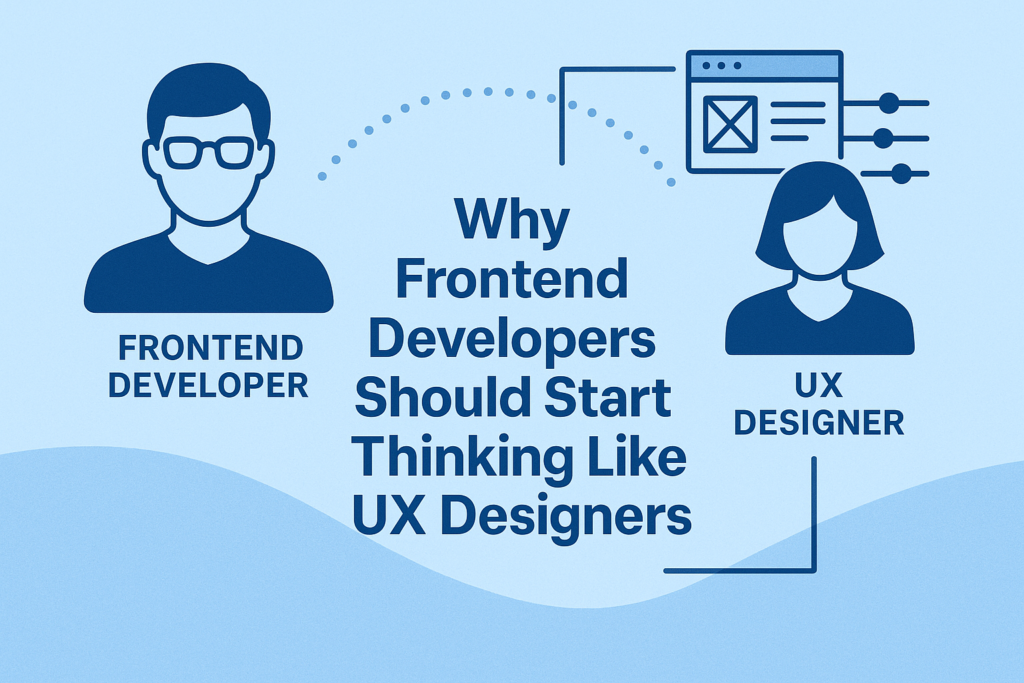
Why Frontend Developers Should Start Thinking Like UX Designers
When we talk about frontend development, we often talk about frameworks, pixel-perfect layouts, performance optimization, and responsive design. All essential — no doubt.
But here’s something we don’t talk about enough: how it feels to use the thing we build.
The truth is, frontend developers are building more than websites or products — we’re building experiences. And with that comes responsibility. A responsibility to understand how users behave, what frustrates them, what delights them, and how we can make their journey smoother.
In short: Frontend developers need to start thinking like UX designers — not just writing functional code, but crafting meaningful interactions.
Table of Contents
What Even Is UX Design?
UX (User Experience) design is the practice of shaping a product or website around the needs, goals, and behaviors of the user.
It’s not about just making things look “nice” — it’s about making them:
- Usable
- Intuitive
- Efficient
- Enjoyable
UX includes everything from how easy it is to fill out a form, to how fast a page loads, to how clear your error messages are. It’s the stuff people remember long after they forget which JavaScript framework you used.
The Overlap: Frontend Dev Meets UX
Here’s the thing: Frontend developers already influence UX — every single day.
Whether you mean to or not, the decisions you make affect how someone feels when they use your site or product:
| Code Decision | UX Impact |
|---|---|
| Loading spinners | Reduces user anxiety during wait |
| Label placement | Affects form completion speed |
| Button state (disabled vs active) | Prevents user errors |
| Animation timing | Makes app feel responsive or sluggish |
| Mobile breakpoints | Dictate how usable your site is on different devices |
Yet many devs treat UX like someone else’s job. In reality, you’re shaping user experience every time you push code.
Real Talk: How Users See It
Let’s be honest — users don’t care how clean your code is. They won’t praise your React hooks or Tailwind configuration. What they care about is:
“Can I get what I came here for without feeling confused or frustrated?”
If the page is slow, or buttons aren’t working, or the form feels clunky — they’ll leave.
This is where UX mindset kicks in. It’s about empathy. It’s about seeing your interface through the eyes of someone who’s not you.
This Applies to More Than Just Products
Most people associate UX thinking with apps or SaaS tools. But websites — especially content-rich or lead-generation sites — need UX thinking just as much.
Examples:
- A blog with poor readability or broken layout will drive readers away.
- A contact form without inline validation frustrates users.
- A marketing site that buries key information lowers trust and conversions.
- A portfolio site that lacks accessibility excludes entire groups of users.
UX isn’t a product feature — it’s a website’s heartbeat.
UX Thinking in Action for Frontend Devs
So how can you, as a frontend developer, start thinking more like a UX designer? Here are practical shifts you can make:
1. Ask “Why?” Before “How?”
Before diving into code, ask:
- Why is this button placed here?
- Why does this action take three steps?
- Why are we using a modal instead of a new page?
Asking why brings clarity of purpose, and makes your implementation aligned with the user’s journey — not just the design spec.
2. Care About Microinteractions
Small things = big impact.
- How does the form respond to incorrect input?
- Does the hover state give a visual cue?
- Is the error message helpful or cryptic?
These are the little moments where users feel either cared for or ignored.
3. Think Mobile First (But Actually Do It)
We all say it, but few implement it properly. UX on mobile isn’t just about stacking divs vertically — it’s about touch targets, scroll behavior, speed, and layout clarity.
4. Know That Accessibility Is UX
- ARIA labels
- Keyboard navigation
- Sufficient color contrast
- Focus states
Accessibility isn’t just for compliance — it’s part of inclusive, human-centered design. If you’re leaving someone behind, that’s a UX failure.
The SEO and Business Case for Better UX
Here’s where it ties into Google’s E-E-A-T framework — Experience, Expertise, Authoritativeness, Trustworthiness.
When your site is:
- Easy to use (Good UX = good experience)
- Technically solid (Performance, accessibility, structured content)
- Clear and helpful (No dark patterns or shady behavior)
Google sees this and rewards it with better ranking and more visibility.
UX = SEO = Business Results.
Final Thoughts: Be a Developer Who Designs With Empathy
You don’t need to become a full-time designer. But thinking like one will make you a far better developer.
You’ll write smarter code.
You’ll catch bad UX before it ships.
You’ll build products — and websites — that people actually enjoy using.
That’s not just better for your users. It’s better for your team, your business, and your career.
Quick Resources to Start UX Thinking as a Developer
- a11yproject — Accessibility made easy
- UX Playbook by Google — For specific verticals
Over to You
Have you started blending dev and design thinking in your projects?
Have you faced pushback — or breakthroughs — when advocating for better UX?
Share your stories in the comments. Let’s learn from each other.
